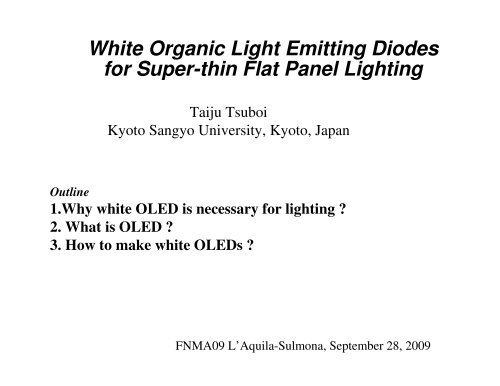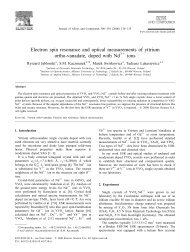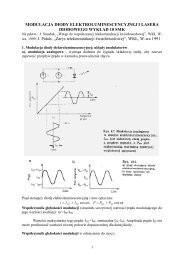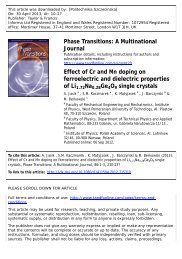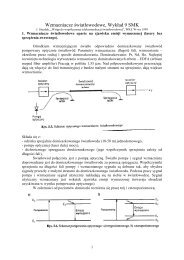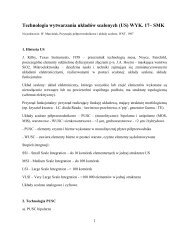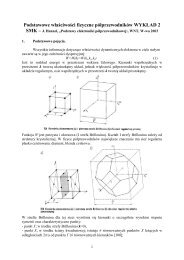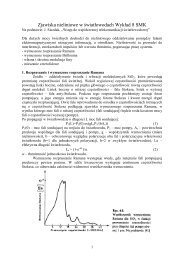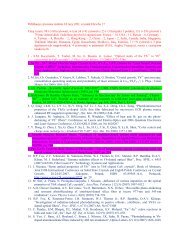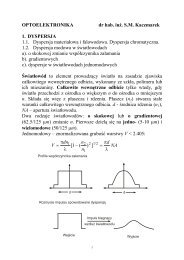White Organic Light Emitting Diodes for Super-thin Flat Panel Lighting
White Organic Light Emitting Diodes for Super-thin Flat Panel Lighting
White Organic Light Emitting Diodes for Super-thin Flat Panel Lighting
You also want an ePaper? Increase the reach of your titles
YUMPU automatically turns print PDFs into web optimized ePapers that Google loves.
<strong>White</strong> <strong>Organic</strong> <strong>Light</strong> <strong>Emitting</strong> <strong>Diodes</strong><br />
<strong>for</strong> <strong>Super</strong>-<strong>thin</strong> <strong>Flat</strong> <strong>Panel</strong> <strong>Light</strong>ing<br />
Taiju Tsuboi<br />
Kyoto Sangyo University, Kyoto, Japan<br />
Outline<br />
1.Why white OLED is necessary <strong>for</strong> lighting ?<br />
2. What is OLED ?<br />
3. How to make white OLEDs ?<br />
FNMA09 L’Aquila-Sulmona, September 28, 2009
electricity consumption in Japanese houses<br />
16%<br />
lighting<br />
TV<br />
10%<br />
heating<br />
4%<br />
29%<br />
others<br />
16%<br />
refrigerator<br />
25%<br />
Air-condition<br />
Japanese Government report
Why OLED lighting and OLED displays are needed ?<br />
Because of Shortage of Oil Resource<br />
Production of Oil<br />
No more oil after 40 years ?<br />
Low-energy consuming lighting and display are needed.
Power efficiency of lighting<br />
power efficiency: η = πL(cd)/J(A)V(V)<br />
Incandescent lamp(100W): 16~18 lm/W<br />
Xe lamp : 25~35 lm/W<br />
Fluorescent lamp:<br />
40~110 lm/W<br />
<strong>White</strong> LED (Cree, USA):<br />
<strong>White</strong> LED (Nichia, Japan):<br />
131 lm/W<br />
150 lm/W<br />
<strong>White</strong> OLED (Universal Display Corp., USA) :102 lm/W (2008.6.) at1000cd/m 2<br />
<strong>White</strong> OLED (Novaled AG, Germany):90 lm/W at 1000cd/m2 ,<br />
with attachment 124 lm/W (2009.5.)<br />
Problems:<br />
LED: shortage of rare metals like In and Ga<br />
Fluorescent lamp : containing Hg
<strong>Organic</strong> Electronics<br />
Every<strong>thin</strong>g by organic materials<br />
Displays<br />
Electronic paper<br />
Transistor, Condenser<br />
Solar cell<br />
Lasers : Easily tunable and any emitting color<br />
New <strong>Light</strong>ing using white OLED<br />
General Electric Global<br />
Research Co.<br />
Fraunhofer Institut für Photonische<br />
Mikrosysteme (IPMS) in Dresden<br />
OSRAM
Progress of TV displays<br />
CRT-TV<br />
Liquid Crystal Display<br />
Plasma Display <strong>Panel</strong><br />
Contrast: 3,000 : 1 Contrast: 8,000 : 1<br />
<strong>Organic</strong> <strong>Light</strong> emitting diode (OLED) display<br />
SONY OLED 11’ TV「XEL-1」<br />
Dec., 2007<br />
Thickness: 3 mm<br />
Consumption power: 45 V<br />
Contrast: 1,000,000:1
Principle of LC Display<br />
polarizer<br />
Electric field plane of light<br />
V=0<br />
polarizer<br />
No light<br />
bright<br />
Nematice liquid crystal<br />
dark<br />
V<br />
E(=V/d)<br />
Orientation of LC is changed by applied voltage
Advantage of OLED devices<br />
1.Self-emission, No back-light<br />
2.High response, wide viewing angle<br />
3.High contrast image<br />
4.<strong>Super</strong>-<strong>thin</strong> flat, lightweight<br />
5.Flexible, paper-like display<br />
6.Low voltage operation 5V: Low cost operation<br />
7.<strong>Organic</strong> materials: Easy manufacturing<br />
8. Low cost <strong>for</strong> production<br />
Universal Display Corp.<br />
Fraunhofer Institut für Photonische<br />
Mikrosysteme (IPMS) in Dresden<br />
OSRAM
<strong>Organic</strong> <strong>Light</strong> <strong>Emitting</strong> Diode (OLED) with organic semiconductors<br />
3-7V<br />
0.4µm<br />
Metal cathode<br />
- - - - - - -<br />
+++++++<br />
transparent ITO anode<br />
Electron<br />
Transport layer<br />
emitting layer<br />
hole transport<br />
layer<br />
Glass plate<br />
Emission by Recombination of electron and<br />
hole : Electroluminescence<br />
Inorganic LED<br />
-<br />
+<br />
electron crystal<br />
n 型<br />
p 型<br />
-<br />
+<br />
hole<br />
Kyoto Sangyo Univ.<br />
Green and Red OLEDs<br />
Kyoto Sangyo Univ.<br />
<strong>White</strong> OLEDs
Actual OLED with multi-layers<br />
<strong>for</strong> carrier balance and confinement<br />
to make high density excitons<br />
Al<br />
LiF<br />
Cathode<br />
Electron injection<br />
layer<br />
ETL<br />
Emission layer<br />
HTL<br />
Hole injection layer<br />
Anode----ITO glass substrate<br />
Electroluminescence EL<br />
Guest-Host system<br />
emitter is doped in host<br />
e.g. green Ir(ppy<br />
ppy) 3<br />
in CBP,<br />
red PtOEP in CBP,<br />
Transparent Anode<br />
red DCM1 in Alq 3<br />
5.0<br />
EL<br />
ITO<br />
+<br />
LUMO<br />
1.9eV<br />
α-NPD<br />
ITO<br />
Glass Substrate<br />
NPD<br />
5.2eV<br />
Ir(ppy) 3 : CBP<br />
2.9<br />
PtOEP<br />
+<br />
-<br />
5.3<br />
Alq 3<br />
BCP<br />
2.76<br />
BAlq<br />
2.8<br />
Alq<br />
5.41<br />
-2.9eV<br />
LiF/Al<br />
0.32µm<br />
excitons<br />
HOMO<br />
5.9
confinement electrons and holes in emitting layer<br />
Hole injection layer<br />
LUMO<br />
ITO<br />
3.09<br />
CuPc<br />
2.45<br />
α-NPD<br />
+ 4.7eV 5.02 +<br />
5.46<br />
HOMO<br />
Hole transport layer Emission by e-h recombination<br />
Electron blocking layer<br />
+<br />
2.7<br />
Ir(ppy) 3<br />
in CBP<br />
5.52<br />
- 2.9 - 3.0 -<br />
Al -<br />
+<br />
BCP<br />
6.4<br />
<strong>Emitting</strong> layer<br />
Alq3<br />
5.7<br />
4.2<br />
electron<br />
Electron injection layer<br />
Electron transport layer<br />
Hole blocking layer<br />
hopping<br />
ITO<br />
hopping<br />
LUMO<br />
Al<br />
HOMO
2<br />
1.89eV<br />
ー<br />
CBP<br />
2.9eV<br />
Al/LiF cathode<br />
HOMO<br />
host<br />
hopping<br />
3<br />
exciton<br />
hole and then electron<br />
are trapped at dopant<br />
carrier hopping in HOMO and LUMO<br />
levels in amorphous semiconductor film<br />
dopant<br />
Removal of electron from hole<br />
transport molecules α-NPD<br />
2.9eV<br />
Ir(ppy)3<br />
5.1eV<br />
3<br />
2<br />
CBP<br />
5.52eV<br />
hopping<br />
LUMO<br />
ITOanode<br />
5.0eV +<br />
1<br />
electron<br />
hole<br />
Molecular states<br />
of dopant<br />
2<br />
1<br />
N: (1s) 2 (2s) 2 (2p) 3
How to increase the quantum efficiency in OLED ?<br />
1. High numbers of injected electrons and<br />
holes in emitting layer<br />
good injection layer<br />
high carrier mobility materials<br />
confinement of electrons and holes<br />
Cathode<br />
Anode<br />
Electron<br />
Scheme of EL Process<br />
γ<br />
Hole<br />
2. Same number of electrons and holes<br />
because exciton is <strong>for</strong>med by e+h<br />
3. All excitons should be used <strong>for</strong> emission<br />
Phosphorescent emitter is the best.<br />
4. Emission should be taken outside from<br />
emitting layer inside of OLED efficiently<br />
Conduction Band<br />
(LUMO)<br />
η ex<br />
Singlet Exciton<br />
Electron-Hole<br />
Capture; Exciton<br />
Valence Band<br />
(HOMO)<br />
Triplet Exciton<br />
Cathode<br />
Electron<br />
injection layer<br />
ETL<br />
Emission layer<br />
HTL<br />
Hole injection<br />
layer<br />
Anode----ITO glass<br />
substrate<br />
η r<br />
<strong>Light</strong> Emission<br />
<strong>Light</strong> Output Internal Decay<br />
η out<br />
Heat Dissipation
Electroluminescence spectra<br />
emission intensity (arb. units)<br />
0.02 Ir1<br />
Ir(ppy) 3<br />
0.01<br />
0.00<br />
Mono color white color<br />
Pt2<br />
PtOEP<br />
400 450 500 550 600 650 700 750<br />
wavelength (nm)<br />
electroluminescence (arb. units)<br />
0.07<br />
0.06<br />
0.05<br />
0.04<br />
0.03<br />
0.02<br />
0.01<br />
0.00<br />
blue<br />
at 5 V<br />
<strong>White</strong> OLED<br />
red<br />
400 450 500 550 600 650 700 750<br />
wavelength (nm )<br />
PtOEP<br />
(Platinum<br />
octaethylporphyrin)<br />
Ir(ppy) 3<br />
tris(2-phenylpyridine)<br />
iridium
Currently available OLED displays<br />
Cellar phone with OLEDs<br />
Kodak Digital Camera<br />
Fujitsu<br />
LS433 LCD<br />
LS633 OLED<br />
SAMSUNG AMOLED TL320 Digital camera<br />
12.2 Mega Pixels<br />
F900i<br />
F506i<br />
Feb., 2004 May, 2004<br />
Main LCD 262,144 colors 2.4“TFT<br />
Front OLED 4,096 colors 1.1“<br />
Kodak One-Seg OLED TV
Currently used OLED display<br />
Victor Co. Audio compo<br />
Pioneer Co., Display panel <strong>for</strong> automobiles<br />
portable audio player<br />
Matsushita Co.,<br />
Sony<br />
Olympus
What lighting is good <strong>for</strong> us ?<br />
Materials should be seen under lighting just as seen under sun.<br />
<strong>White</strong> light as sunshine<br />
CRI color rendering index<br />
under sunshine CRI=100 (standard)<br />
usual f. lamp CRI 60<br />
sunlight<br />
3-λ f. lmap CRI 80<br />
color temperature: 2500-6000K<br />
chromaticity index CIE (0.33, 0.33)<br />
CRI>80<br />
3-λ naturalf.lmap CRI 90 http://map.answerbox.net/landmark-368647-bbs-2.htm
generation of white light<br />
A. RBG parallel<br />
B. <strong>White</strong> with<br />
RGB color filters<br />
C.Color conversion: B to G, B to R<br />
D. Tandem structure<br />
E. Single emitting layer<br />
Al<br />
Alq 3<br />
(55nm)<br />
BAlq(20nm)<br />
EML<br />
NPD(60nm)<br />
ITO<br />
Grass substrate<br />
R,B emission<br />
R,G,B emission
2-color B+G WOLED<br />
DSA-ph<br />
TBRb<br />
A<br />
B<br />
G<br />
B<br />
青 色<br />
オレンジ<br />
B<br />
G<br />
B<br />
A<br />
Device A is much better than Device B.<br />
Y.S. Wu et al, Thin Solid Films 488(2005)265.
3-layer emission due to Bepp2, Alq3, Rubrene<br />
Z.Y. Xie et al, APL, 74(1999) 641
3-Layer emission<br />
CIE = (0.33, 0.33)<br />
CCT(correlated color Temp.)= 2500-6000 K<br />
CRI(color rendering index) > 80<br />
Zhu, Li, Tsuboi, et al, Opt. Lett. 32(2007) 3537.
High external efficiency from POLED with three small<br />
molecules<br />
WOLED1 ; 16.6 %<br />
FIr6: bis(40,60-difluorophenylpyridinato) tetrakis(1-pyrazolyl)borate<br />
PQIr: Ir(III) bis(2-phenylquinolyl-N,C20) acetylacetonate<br />
Reducing hole mobility <strong>for</strong> charge balance, Uni<strong>for</strong>m<br />
distribution of holes and electron.<br />
Ambipolar host <strong>for</strong> uni<strong>for</strong>m exciton <strong>for</strong>mation across<br />
the entire EML<br />
WOLED2; 6.0%<br />
Y. Sun, S.R. Forrest, Org. Electron.9 (2008) 994.
OLEDs with Exciplex emission
0.6<br />
0.5<br />
BPhen+m-MTDATA(1:1)<br />
monomer<br />
Exciplex emission<br />
optical density<br />
0.4<br />
0.3<br />
0.2<br />
0.1<br />
m-MTDATA<br />
BPhen<br />
0.0<br />
250 300 350 400 450 500<br />
wavelength (nm)<br />
4,4’,4”-tris[3-methylpheny-l(phenyl)amino] triphenylamine (m-MTDATA): hole-transport material :<br />
M M + + e<br />
4,7 dipheny-1,10-phenanthroline (Bphen): electron-transport material : B + e B -<br />
6620cd/m 2 at 8.7V<br />
M + + B - (MB)* MB + hν<br />
emission from interface<br />
B<br />
M -<br />
+<br />
donor<br />
acceptor<br />
D. Wang, W.L.Li, T. Tsuboi et al, APL 92(2008)053304.<br />
No emission from Bphen monomer
<strong>White</strong> OLED with exciplex and monomer<br />
monomer<br />
exciplex<br />
2000 cd/m 2<br />
0.58 lm/W<br />
CIE (0.31,0.35)<br />
J. Feng et al, APL78 (2001) 3947.
<strong>White</strong> OLED using only exciplex<br />
Monomer<br />
emission<br />
Exciplex emission<br />
Al(DBM)<br />
Bphen<br />
m-MTDATA<br />
TPD<br />
Very wide broad band<br />
EL<br />
J.Z. Zhu, W.L. Li, T. Tsuboi, et al,<br />
to be published.
Four exciplexes in a device<br />
boundary exciplex<br />
m-MTDATA<br />
Intralayer exciplex<br />
acceptor<br />
donor
Increase of Intralayer exciplex<br />
R=<br />
M-MTDATA:Al(DBM) 3<br />
Decrease of R:<br />
Decrease of m-MTDATA<br />
Decrease of red exciplex
Multi-coloration by single molecule<br />
Excimer<br />
Mixed ligand molecule
Single dopant WOLED<br />
with Excimer emission<br />
M*M M + M + hυ<br />
excimer<br />
FPt monomer<br />
excimer<br />
*T. Tsuzuki, S. Tokito, Proc. Int. <strong>Super</strong>-Functionality<br />
<strong>Organic</strong> Devices, IPAP Conf. Series 6 (2005) 99.<br />
Pt compounds: plane structure, stacking<br />
N^C^N-Pt(<br />
Pt(Cl<br />
Cl)<br />
cyclometalated Pt 2+ -compounds<br />
FPt<br />
QE= 6.1% , CRI=73, CIE=(0.32, 0.39), 11.8 lm/W (at 1cd/m2)<br />
V. Adamovich et al, New J. Chem. 26 (2002) 1171.
polymer or small molecule ?<br />
Polymer:<br />
spin-coating, wet-process: cheap, easy, simple<br />
structure (2-layer), and ink-jet possible (<strong>for</strong> massproduction)<br />
Small molecule:<br />
thermal evaporation in high vacuum, dry process: high<br />
cost
Polymer <strong>White</strong> OLEDs<br />
A. Dispersion type (doping, blend, guest-host)<br />
dopant host emitter<br />
FL small molecule FL polymer Dopant<br />
PL small molecule FL polymer Dopant<br />
FL polymer FL polymer Dopant<br />
FL: Fluorescent<br />
PL: Phosphorescent<br />
PL polymer FL polymer Dopant+host<br />
PL polymer PL polymer Dopnat+host<br />
B. Single polymer<br />
emitter<br />
Non-copolymer Monomer+Excimer FL polymer<br />
Non-copolymer Monomer+Electromer FL polymer<br />
Blended in backbone,<br />
copolymer<br />
Blended in side-chain,<br />
copolymer<br />
Monomer<br />
Monomer<br />
PL polymer<br />
PL polymer
Guest polymer + host polymer<br />
0.05wt% PPDB(polyperiren-ethylbenzen)dopant<br />
m-LPPP(ladder-type paraphenyrene)<br />
host<br />
EL, M-LPPP PL,PPDB<br />
Ext. Effic: 1.2 %,<br />
CIE(0.31, 0.33)<br />
M-LPPP<br />
PPDB<br />
ITO/ 0.05%PPDB:m-LPPP /Al<br />
S. Tasch et al, APL 71(1997)2883.
Doped WPLED: Polymer-doped polymer<br />
host<br />
ITO/PEDOT/0.6wt%MEH-PPV:PF/Ba/Al<br />
PL<br />
host<br />
guest<br />
F.Z. Shen et al, Semicon. Sci. Technol. 21(2006)L16.<br />
Ext. Effic: 0.95 %
Carrier balanced green polymer<br />
M. Suzuki (NHK) et al, APL 86(2005)103507<br />
PL<br />
TPD as HT<br />
PBD as ET<br />
Ir(ppy) 2<br />
(acac) as EL<br />
TPD:PBD:Ir(ppy) 2<br />
(acac)=<br />
(A)55:41:4, (B)36:62:4, (C)18:79:3<br />
濃 度 比 が 重 要<br />
η ext<br />
=11.8% at 0.12mA/cm2,<br />
power effi.= 38.6 lm/W at 0.02mA/cm2<br />
with Cs e-injector<br />
c.f. S. Lamansky et al, JACS123(‘01)4304:<br />
Ir(ppy) 2<br />
(acac) in CBP host, multi-layer<br />
OLED<br />
12.3%, 38 lm/W, >50 Cd/A
Guest-Host system or Non-doped system ?<br />
ETL<br />
<strong>White</strong> OLEDs<br />
ETL<br />
HTL<br />
HTL<br />
Non-dopant system is much better than guest-host system<br />
Because<br />
1. Best concentration is 1-2% dopant, difficult to control it<br />
wi<strong>thin</strong> ±0.5% in mass produced OLEDs<br />
2. For <strong>White</strong> OLED, blue-green-red stacking layered OLED<br />
gives rise to energy transfer from blue to green to red layer、color<br />
instability
Single polymer WOLEDs<br />
polymer<br />
Backbone copolymer<br />
Side-chain copolymer<br />
Mono-dopant polymer<br />
*<br />
monomer<br />
Excimer<br />
Electromer
Single backbone copolymer<br />
C.Y. Chuang et al, Macromol.40(2007)247<br />
PF:Polyfluoren,<br />
a bipolar charge-tranporting PF derivative<br />
単 一 高 分 子 型
ackbone copolymer D.Ma<br />
Different dopant:<br />
red-emitter2,1,3-benzothiadiazoleincorporated<br />
blue-polymer<br />
BPFB-BT-3<br />
BPF-BT-3<br />
8.99cd/A, 5.75lm/W, η=3.8%<br />
c.f. 3.8cd/A, 2.0lm/W, η=1.50%<br />
J. Liu et al, Adv. Func. Mat. 16(2006)957.
PF<br />
BT<br />
FL+PL<br />
J.X. Jiang et al, Adv. Mater. 18(2006)1769.<br />
Phq<br />
Phosphorescence<br />
赤 色 発 光 :<br />
緑 色 発 光 :<br />
青 色 発 光 :<br />
フェニルキノリンIr 錯 体 Phq 燐 光 分 子<br />
ベンゾチアヂアゾルBTの 蛍 光 分 子<br />
発 光 分 子 基 はフルオレンPFの 蛍 光 分 子<br />
パワー 効 率 1.9cd/A、 最 高 輝 度 3585cd/m 2
<strong>White</strong> light using color conversion method<br />
Green (515 nm) phosphorescence emitter : Ir(ppy) 3<br />
ITO/α-NPD/6.2mol% Ir(ppy) 3<br />
:TCTA/CF-X/Alq 3<br />
/LiF/Al<br />
TCTA host; η ext = 19.2 % M. Ikai et al., APL 79 (2001)156.<br />
Blue (465nm) phosphorescence emitter: Firpic<br />
ITO/CuPc/α-NPD/6%FIrpic:host/BAlq/LiF/Al<br />
CBP host; η ext = 6.1%, 7.7 lm/W<br />
mCP host; η ext = 7.5%, 8.9 lm/W R.J. Holmes et al., APL 82(2003)2422.
External quantum efficiency<br />
η ext (%) = γ η ex η r η out<br />
Scheme of EL Process<br />
= η int η out<br />
γ : carrier injection balance<br />
η ex : exciton <strong>for</strong>mation efficiency<br />
η r<br />
: exciton recombination efficiency<br />
0.25 <strong>for</strong> singlet exciton, 1.0 <strong>for</strong> triplet exciton<br />
η out : outcoupling effi. <strong>for</strong> light from OLED<br />
η out ~ 1/2n a<br />
2<br />
(=20%)<br />
Phosphorescent emitters<br />
η int =100% , η ext (%) = 20 %<br />
Cathode<br />
Electron<br />
Conduction Band<br />
(LUMO)<br />
η ex<br />
Singlet Exciton<br />
γ<br />
Electron-Hole<br />
Capture; Exciton<br />
Anode<br />
Hole<br />
Valence Band<br />
(HOMO)<br />
Triplet Exciton<br />
η r<br />
<strong>Light</strong> Emission<br />
Heat Dissipation<br />
<strong>Light</strong> Output<br />
Internal Decay<br />
η out
Host materials <strong>for</strong> blue emitters<br />
Currently very weak efficiency<br />
ITO/CuPc/α-NPD/6%FIrpic:host/BAlq/LiF/Al<br />
CBP: 6.1%, 7.7 lm/W<br />
mCP:7.5%, 8.9 lm/W<br />
R.J. Holmes et al., APL 82(2003)2422.<br />
emission intensity (arb. units)<br />
8<br />
6<br />
4<br />
2<br />
0<br />
CBP<br />
S 1<br />
emission<br />
2<br />
1<br />
λ exc<br />
=300nm at 10K<br />
3<br />
CBP T 1<br />
emission<br />
4<br />
1 FIrpic/CBP<br />
2 FIrN4/CBP<br />
3 FIrpic/SimCP<br />
4 FIrN4/SimCP<br />
375 400 425 450 475 500 525 550 575<br />
wavelength (nm)<br />
2<br />
1<br />
Highly stable (high glass transition temp.),<br />
high carrier mobility,<br />
high T 1<br />
energy level hosts are necessary.<br />
PL intensity (arb. units)<br />
4<br />
3<br />
2<br />
1<br />
0<br />
S 1<br />
emission<br />
T 1<br />
emission<br />
12 K<br />
CBP on quartz<br />
x15<br />
400 440 480 520 560 600<br />
wavelength (nm)<br />
0.25<br />
0.20<br />
0.15<br />
0.10<br />
0.05<br />
0.00<br />
PL intensity (arb. units)
The best host material <strong>for</strong> blue emitter in OLEDS<br />
mCP SimCP SimCP2<br />
N<br />
N<br />
SimCP2<br />
Si<br />
N<br />
N<br />
bis(3,5-di(9H-carbazol-9-yl)<br />
phenyl)diphenylsilane (SimCP2)<br />
Counting Rate (cps)<br />
2000<br />
1500<br />
1000<br />
500<br />
non-annealed<br />
70 o C<br />
120 o C<br />
150 o C<br />
Carrier mobility (cm 2 /Vs)<br />
: (h) Hole carrier mobility<br />
10 -3 : (e) Electron carrier mobility<br />
SimCP2<br />
(h)<br />
mCP<br />
10 -4<br />
(e)<br />
(h) (e)<br />
100 200 300 400 500 600 700 800<br />
Electric field 1/2 (V/cm) 1/2<br />
SimCP<br />
(h)<br />
(e)<br />
PL intensity (normalized)<br />
1.2<br />
1.0<br />
0.8<br />
0.6<br />
0.4<br />
0.2<br />
0.0<br />
4<br />
PLE<br />
5<br />
PL<br />
1<br />
1 3wt% PL<br />
2 15wt% PL<br />
3 20wt% PL<br />
4 3wt% PLE<br />
5 20wt% PLE<br />
280 320 360 400 440<br />
wavelength (nm)<br />
3<br />
2<br />
10K<br />
0<br />
5.0 5.2 5.4 5.6 5.8 6.0 6.2 6.4<br />
Energy(eV)<br />
SimCP2: Tg= 148 C<br />
mCP: 55 C<br />
SimCP: 101 C<br />
CBP: 62 C<br />
SimCP2 HOMO : 6.12 eV<br />
LUMO : 2.56 eV,<br />
η ext<br />
of 17.7 % and power efficiency of 24.2 lm/W at 100 cd/m 2 <strong>for</strong> FIrpic<br />
ITO/PEDOT:PSS(35nm)/14 wt% FIrpic:SimCP2(35nm)/TPBi(28nm)/LiF/Al<br />
c.f., 10.4 and 5.9 lm/W in the case of SimCP and mCP hosts, respectively<br />
T. Tsuboi., M.-F. Wu, S.-W. Liu, C.-T. Chen, Org. Electron. (2009), in press.
Copolymer with Rare-earth-complex organic molecules<br />
Eu<br />
high color purity with sharp lines<br />
Tb<br />
Eu<br />
Tb
<strong>White</strong> OLED with rare-earth small molecules<br />
(a)<br />
(b)<br />
Sm<br />
Eu<br />
FIrpic<br />
PBD<br />
Z. Kin et al., Mater. Res. Soc. Symp. Proc. Vol. 965(2007) 0965-S04-02
Small molecule: Dual emission from a single molecule<br />
473nm: Ir(dfppy)<br />
544nm: Ir(pq)<br />
Ir(dfppy) 2<br />
(acac): 469nm PL<br />
Ir(pq) 2<br />
(acac): 597nm PL<br />
Host: UGH2<br />
1,4-phenylenesis (triphenylsilane)<br />
Max: 11.0 cd/m 2 , 5.60 lm/W<br />
J.H. Seo et al, Thin Solid Films 516(2008)3614.


